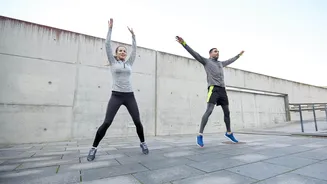Understanding Parkinson's Disease
Parkinson's disease is a progressive neurological disorder that impacts the central nervous system, primarily affecting movement. It is characterized by
symptoms such as tremors, rigidity, slowness of movement (bradykinesia), and postural instability. The cause of Parkinson's is not completely understood, but it is believed to involve a combination of genetic and environmental factors. As the disease progresses, it can lead to a variety of motor and non-motor symptoms, impacting daily activities and overall quality of life. The impact of the condition varies widely among individuals, emphasizing the importance of personalized management strategies that consider the unique needs of each person. Understanding the condition’s mechanisms and effects is essential for effectively managing its symptoms and promoting well-being.
Exercise's Crucial Role
Exercise is a cornerstone of managing Parkinson's disease, playing a crucial role in mitigating symptoms and improving overall function. Regular physical activity can help to maintain and enhance motor skills, balance, and coordination, which are often compromised by the disease. Exercise can also improve mood and reduce symptoms of depression and anxiety, common among those with Parkinson's. Furthermore, exercise can help to increase strength, flexibility, and cardiovascular fitness, contributing to a better quality of life. Consistent participation in exercise programs helps delay the progression of the disease and allows those affected to maintain independence for as long as possible. The benefits extend beyond physical health, positively impacting mental and emotional well-being, thus making exercise an indispensable part of comprehensive Parkinson's care.
Chair Squats Benefits
Chair squats are a gentle yet effective exercise that can be easily incorporated into a daily routine. They help to strengthen leg muscles, which are often weakened by Parkinson's. To perform chair squats, begin by standing in front of a sturdy chair. Slowly lower your body towards the chair as if you are going to sit, keeping your back straight and your core engaged. Gently tap your buttocks on the chair, then stand back up. This movement improves leg strength, aiding in activities such as walking and standing up from a chair. Performing multiple repetitions with short rests can help enhance endurance. This simple exercise offers a practical way to maintain mobility and strength, which are essential for those living with Parkinson's. Regular practice can lead to increased confidence and improve the ability to perform everyday tasks.
Stretching for Flexibility
Stretching is fundamental for maintaining flexibility and reducing muscle stiffness, a common symptom of Parkinson's disease. Regular stretching exercises help to improve the range of motion in the joints and prevent muscles from becoming tight and painful. Simple stretches, such as reaching for the ceiling or rotating the shoulders, can make a difference. These exercises also promote better posture, which often becomes a challenge as the disease progresses. When engaging in stretches, focus on slow, controlled movements and avoid bouncing. Consistency is important, aiming for stretching sessions several times a week. Stretching sessions can easily be added to your daily routine, enhancing physical comfort and promoting better overall well-being. Regular stretching will facilitate more effortless movement and enhance the quality of daily life.
Hand and Finger Exercises
Hand and finger exercises are crucial for maintaining fine motor skills, which can become impaired due to Parkinson's. These exercises target dexterity and coordination, which can make daily activities easier. Simple movements, like making a fist and opening your hand, or touching each finger to your thumb, help in maintaining mobility in the hands and fingers. Practicing these exercises regularly, even for a few minutes each day, supports the ability to perform tasks like buttoning clothes, writing, and using utensils. Performing these exercises can improve both physical function and psychological well-being by allowing greater independence and self-sufficiency. These focused activities play a crucial role in maintaining function and enhancing the quality of daily life for people with Parkinson's.
Importance of Balance Training
Balance training is critical for preventing falls, a major concern for individuals with Parkinson's. Exercises that improve balance help to enhance stability and coordination, reducing the risk of injuries. Simple activities, such as standing on one foot or walking heel-to-toe, can significantly improve balance. It is important to perform these exercises in a safe environment, ideally near a supportive surface like a wall or chair. Consistency is key, and aiming for these exercises several times a week can greatly improve stability. Balance training not only reduces fall risk but also boosts confidence and enhances the ability to navigate daily life more safely. Integrating balance training into the routine helps to maintain independence and improve the overall quality of life.













